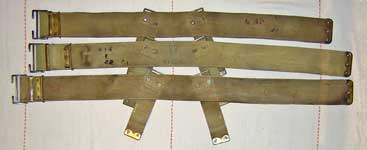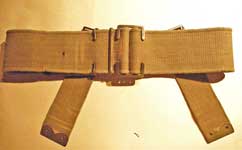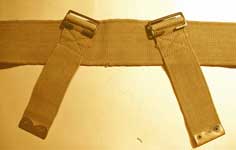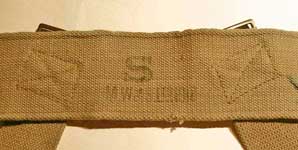W.E. Patt. '08 Waist belts
Introduced with the W.E. Patt. '08 by List of Changes L. of C. §14288, dated 31st January 1908, the Belt, waist, was the center of the W.E. Patt. '08 system. All of the components attached to the Belt, the Braces, or both. This allowed the entire Web Equipment to be put on and taken off fully assembled, like a waistcoat. This was a significant improvement over earlier patterns, in which each item had its own sling or strap and had to be put on separately. The Waist belt underwent several changes during its service life.
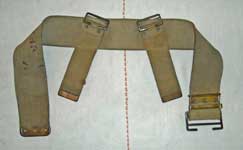
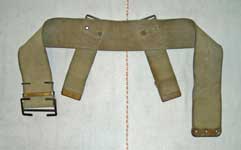 As first introduced with W.E., Patt. '08, the Waist belt was 3-inches wide and came in two lengths, Small (40-inches long) and Large (48-inches long). The Belt is fastened by a double Twigg buckle at the front, and is adjustable at the buckle end. There are two 2-inch web tabs attached at the rear. These tabs are angled outwards. Each tab has a 2-inch Twigg buckle at the top and a brass tip on the bottom end. In the early Belts, such as the one shown here, this is a plain brass tip that is simply crimped in place. This belt is maker marked "M.E. Co.", size marked "S", and dated 1908. From the Karkee Web Collection.
As first introduced with W.E., Patt. '08, the Waist belt was 3-inches wide and came in two lengths, Small (40-inches long) and Large (48-inches long). The Belt is fastened by a double Twigg buckle at the front, and is adjustable at the buckle end. There are two 2-inch web tabs attached at the rear. These tabs are angled outwards. Each tab has a 2-inch Twigg buckle at the top and a brass tip on the bottom end. In the early Belts, such as the one shown here, this is a plain brass tip that is simply crimped in place. This belt is maker marked "M.E. Co.", size marked "S", and dated 1908. From the Karkee Web Collection.
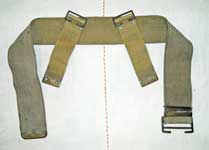
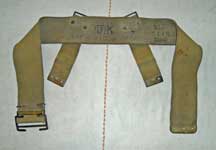 List of Changes entry L. of C. §14687, dated 4th May 1909 added a Medium size (44-inches long) belt to W.E., Patt. '08.
List of Changes entry L. of C. §14687, dated 4th May 1909 added a Medium size (44-inches long) belt to W.E., Patt. '08.
Later that same year, List of Changes entry L. of C. §15048, dated 22nd November 1909, made a number of changes to the pattern. The only one of these changes that affected the Belt was the change from plain brass tips to eyeletted ones on all tabs and straps. The Belt shown left is in the new Medium size (mark "M") and has the eyeletted tips on the rear tabs. It is maker marked "M.E. Co." and dated 1911. From the Karkee Web Collection.
Here are three Mk. I Patt. '08 Belts. All are maker marked "M.E. Co." From top to bottom they are marked Small, dated 1908; Medium, dated 1912; and Large, dated 1915. From the Karkee Web Collection.
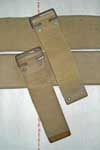 This detail shows the changes to the brass tips specified in L. of C. §15048. The upper Belt is dated 1911, the lower one 1908.
This detail shows the changes to the brass tips specified in L. of C. §15048. The upper Belt is dated 1911, the lower one 1908.
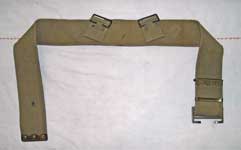
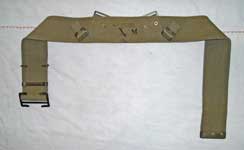 The Belt, waist, special, was added to W.E., Patt. '08 by List of Changes L. of C. §16513, dated 5th March 1913, approved 11th July 1913. This L. of C. entry also introduced the Attachments, brace; the Case, pistol, Webley, with brass hooks; and the Pouch, ammunition, Webley, with brass hooks. Together with the standard Patt. '08 Braces, these components form the Patt. '08 Pistol Order. The Special belt is identical to the regular Belt except at the rear. The 2-inch buckled chapes do not have the down tabs found on the regular Belt, and there are two additional 1-inch buckled chapes on the inside, the buckles facing inward and down. These are used to secure the 1-inch angled straps at the rear of the Brace attachments. This example is a Mark II version (see below), and is maker marked "M.E. Co." and dated 1919. From the Karkee Web Collection.
The Belt, waist, special, was added to W.E., Patt. '08 by List of Changes L. of C. §16513, dated 5th March 1913, approved 11th July 1913. This L. of C. entry also introduced the Attachments, brace; the Case, pistol, Webley, with brass hooks; and the Pouch, ammunition, Webley, with brass hooks. Together with the standard Patt. '08 Braces, these components form the Patt. '08 Pistol Order. The Special belt is identical to the regular Belt except at the rear. The 2-inch buckled chapes do not have the down tabs found on the regular Belt, and there are two additional 1-inch buckled chapes on the inside, the buckles facing inward and down. These are used to secure the 1-inch angled straps at the rear of the Brace attachments. This example is a Mark II version (see below), and is maker marked "M.E. Co." and dated 1919. From the Karkee Web Collection.
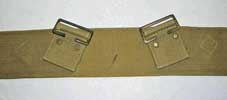
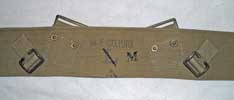 These details show the inside and outside rear chapes and buckles of the Special Waist belt. Originally stamped "L", this Belt has been remarked as "M". Its length actually falls in between the specified lengths for the Mk. II Medium and Large Belts.
These details show the inside and outside rear chapes and buckles of the Special Waist belt. Originally stamped "L", this Belt has been remarked as "M". Its length actually falls in between the specified lengths for the Mk. II Medium and Large Belts.
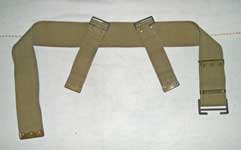
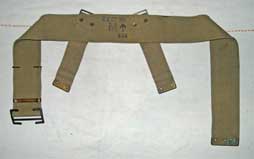 The Belt, waist, Mark II replaced the W.E., Patt. '08 Belt, waist, Mark I in accordance with List of Changes L. of C. §17272, dated 26th May 1915. This L. of C. entry redefined the Belt sizes. Size Small increased from 40-inches to 44-inches long (same as the Mk. I Medium). Size Medium increased from 44-inches to 50-inches long (2-inches longer than a Mk. I Large). Size Large increased from 48-inches to a heroic 56-inches long. These changes applied to both the regular Waist belt and the Special waist belt. I We have seen pictures of apparently genuine Patt. '08 Waist belts marked XL and XXL. These may have been private purchase items. The example shown here is maker marked "M.E. Co." and dated 1919. From the Karkee Web Collection.
The Belt, waist, Mark II replaced the W.E., Patt. '08 Belt, waist, Mark I in accordance with List of Changes L. of C. §17272, dated 26th May 1915. This L. of C. entry redefined the Belt sizes. Size Small increased from 40-inches to 44-inches long (same as the Mk. I Medium). Size Medium increased from 44-inches to 50-inches long (2-inches longer than a Mk. I Large). Size Large increased from 48-inches to a heroic 56-inches long. These changes applied to both the regular Waist belt and the Special waist belt. I We have seen pictures of apparently genuine Patt. '08 Waist belts marked XL and XXL. These may have been private purchase items. The example shown here is maker marked "M.E. Co." and dated 1919. From the Karkee Web Collection.
Late in the War, several components of W.E. Patt. '08 were made in wartime "Economy" versions. In this Belt, the reinforcing rivets have been omitted from the rear tabs, and the flat rolled brass slide to the left of the buckle has been replaced with a simple brass wire loop. This example, maker marked "M.W. & S. Ltd." and dated 1918, is from the collection of Peter Crosby. Photos © Peter Crosby 2008.
Detail showing the rear tabs. The reinforcing rivets are gone and the tabs are simply sewn in place.
Belt, waist, special, "Economy"
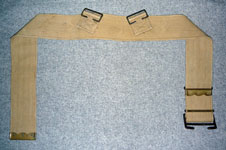
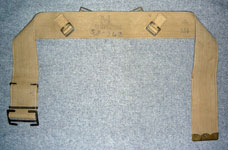 An interesting example of the Special waist belt that exhibits the "
economy" features adopted late in the war. As with the Belt shown just above, the reinforcing rivets have been omitted from the rear tabs, and the flat rolled brass slide to the left of the buckle has been replaced with a simple brass wire loop. Also like the preceding Belt, it is maker marked "M.W. & S. Ltd." and dated 1918. Graham notes that the handwritten "S80343" is an Australian Militia regimental number from WW2. The overall length is 46-inches, which makes it nearer “S” rather than “M”. From the Graham Tweeddale Collection, photos © Graham Tweeddale 2012.
An interesting example of the Special waist belt that exhibits the "
economy" features adopted late in the war. As with the Belt shown just above, the reinforcing rivets have been omitted from the rear tabs, and the flat rolled brass slide to the left of the buckle has been replaced with a simple brass wire loop. Also like the preceding Belt, it is maker marked "M.W. & S. Ltd." and dated 1918. Graham notes that the handwritten "S80343" is an Australian Militia regimental number from WW2. The overall length is 46-inches, which makes it nearer “S” rather than “M”. From the Graham Tweeddale Collection, photos © Graham Tweeddale 2012.
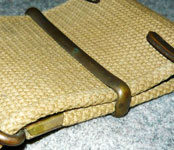 Detail of the brass wire slider. It is a flattened “D” section and contoured to the beaded edges of the Belt.
Detail of the brass wire slider. It is a flattened “D” section and contoured to the beaded edges of the Belt.
Belt, waist, "Walking out" (?) 0r V.T.C. Equipment? UPDATED!
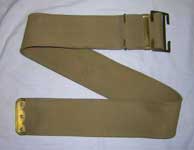
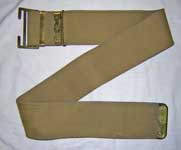 A "Walking out" belt would simply be a Pattern 1908 Waist belt with the rear tabs left off. This would a private purchase item, used in place of the Patt. '08 Belt when the Web Equipment was not being worn. All of this is speculative only, as no solid evidence exists that '08 Walking out belts were ever made and worn. Most inconveniently, soldiers seem to be preferred to be photographed from the front, making the identification of a Walking out belt impossible.
A "Walking out" belt would simply be a Pattern 1908 Waist belt with the rear tabs left off. This would a private purchase item, used in place of the Patt. '08 Belt when the Web Equipment was not being worn. All of this is speculative only, as no solid evidence exists that '08 Walking out belts were ever made and worn. Most inconveniently, soldiers seem to be preferred to be photographed from the front, making the identification of a Walking out belt impossible.
There is also the question of cost. A soldier could easily rig an '08 Brace to double as a Walking out belt, without buying an expensive Belt that would see only occasional use. Many volunteer units used lesser accoutrements, in lighter materials, far removed from "webbing" per se. Some also used obsolete V.E. Patterns in brown leather. There were 351 Volunteer Regiments in 1918, when they were converted to VBs, plus 93 A.S.C. M.T. units, 87 RAMC units, 12 R.E. and 8 Garrison Artillery units. That's 551 units - who've left next to no trace whatever! That's not counting those who'd fallen by the wayside before 1918. The story of what accoutrements each of these organisations wore, and how they changed over time... modern scholarship has only scratched the surface.
The Belt shown left is a Pattern 1908 Waist belt with the rear tabs left off. It is, though, unit marked "1 CVR" (1st Cheshire Vol. Regt.?). Several other similar Belts, also marked "1 CVR", have been reported to KW. To us, this strongly suggests that at least one Volunteer unit used them as uniform equipment. With this Belt, a soldier could carry a Bayonet frog, which at least allowed weapons drill - by the V.T.C. in their progression towards becoming V.B.s under the old Volunteer Act.
Does any reader have better information, either in the form of period photographs or documentation? KW welcomes anyone who can shed further light on this question.
This example is maker marked "M.E. Co." and dated 1916. From the Karkee Web Collection.
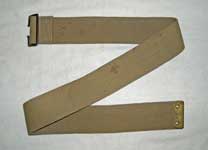
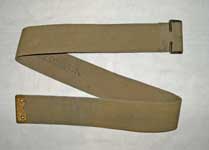 This type of Waist belt is often encountered, but it is not part of the W.E. Patt. '08, at least not in this form. This Belt is converted from a Patt. '08 Brace by cutting off one brass tip and sewing on the 2-inch single Twigg buckle used as a sliding buckle on the Braces. I have documented these as being used in Canada and New Zealand, and they very likely were used in other parts of the Empire as well. Some of them, like this example, are expertly converted, suggesting that the conversion was officially done. Others can be quite crude, and are likely an unofficial "barracks" modification. This example is maker marked "M.E. Co." and dated 1915, but that applies to the Brace - the conversion to Waist belt could have been done at any time. In Barry and Matthew O'Sullivan's New Zealand Army Personal Equipment 1910-1945, the authors' father, Brian O'Sullivan, is shown wearing an identical Belt in training in 1952. From the Karkee Web Collection.
This type of Waist belt is often encountered, but it is not part of the W.E. Patt. '08, at least not in this form. This Belt is converted from a Patt. '08 Brace by cutting off one brass tip and sewing on the 2-inch single Twigg buckle used as a sliding buckle on the Braces. I have documented these as being used in Canada and New Zealand, and they very likely were used in other parts of the Empire as well. Some of them, like this example, are expertly converted, suggesting that the conversion was officially done. Others can be quite crude, and are likely an unofficial "barracks" modification. This example is maker marked "M.E. Co." and dated 1915, but that applies to the Brace - the conversion to Waist belt could have been done at any time. In Barry and Matthew O'Sullivan's New Zealand Army Personal Equipment 1910-1945, the authors' father, Brian O'Sullivan, is shown wearing an identical Belt in training in 1952. From the Karkee Web Collection.
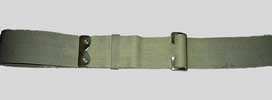
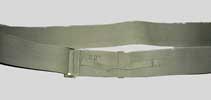 Another, more elaborate version of the Converted waist belt. Again fabricated from a 2-inch Patt. '08 Brace and Twigg buckle, this Belt also has a web slide and this web keeper, a design that looks to be patterned after the B.E. Patt. '03 Belt, waist, web. The only marking is a "52" " size designator. From the Tim Weller Collection, photos © Tim Weller 2009.
Another, more elaborate version of the Converted waist belt. Again fabricated from a 2-inch Patt. '08 Brace and Twigg buckle, this Belt also has a web slide and this web keeper, a design that looks to be patterned after the B.E. Patt. '03 Belt, waist, web. The only marking is a "52" " size designator. From the Tim Weller Collection, photos © Tim Weller 2009.
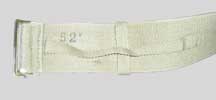 A detail of the same Belt, showing the very professional construction technique.
A detail of the same Belt, showing the very professional construction technique.
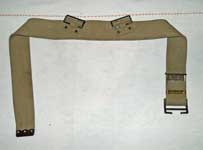
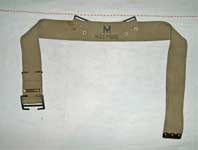 Although this Waist belt is not a part of Web Equipment, Pattern 1908, its similarities to Patt. '08 are obvious. It is modeled after the Patt. '08 Waist belt, but is only 2 ¼-inches wide as opposed to the 3-inch wide Patt. '08 Belt. It most closely resembles the Special Waist belt, but it does not have the internal 1-inch buckled chapes of that version. The short rear buckled chapes, like those of the Special belt, are 2-inches wide, to accept the standard Patt. '08 Braces. So far, KW have not found any primary documentation on this type of Belt. Collectors who have examined it, though, are of the opinion that it is likely to be a Mills private purchase item produced for Officer's and Volunteer Training Corps. It is know that M.E. Co. produced special, lightened versions of W.E. Patt. '08 for these organisations, although the detailed specifics of these special versions have not been found to date.
Although this Waist belt is not a part of Web Equipment, Pattern 1908, its similarities to Patt. '08 are obvious. It is modeled after the Patt. '08 Waist belt, but is only 2 ¼-inches wide as opposed to the 3-inch wide Patt. '08 Belt. It most closely resembles the Special Waist belt, but it does not have the internal 1-inch buckled chapes of that version. The short rear buckled chapes, like those of the Special belt, are 2-inches wide, to accept the standard Patt. '08 Braces. So far, KW have not found any primary documentation on this type of Belt. Collectors who have examined it, though, are of the opinion that it is likely to be a Mills private purchase item produced for Officer's and Volunteer Training Corps. It is know that M.E. Co. produced special, lightened versions of W.E. Patt. '08 for these organisations, although the detailed specifics of these special versions have not been found to date.
This example appears to be unissued. It is maker marked "M.E. Co." and dated 1926. From the Karkee Web Collection.
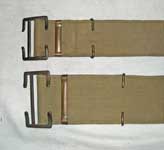 This detail compares the double Twigg buckle of the 2 ¼-inch wide O.T.C Belt with that of the 3-inch wide Patt. '08 Belt. As can be easily seen, they are identical except in width.
This detail compares the double Twigg buckle of the 2 ¼-inch wide O.T.C Belt with that of the 3-inch wide Patt. '08 Belt. As can be easily seen, they are identical except in width.
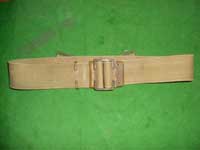
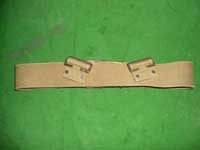
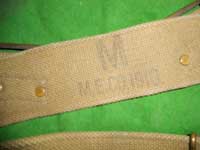 Another example of this type of 2 ¼-inch wide Belt, this time a pre-war example maker marked "M.E. Co.", size marked "M", and dated 1910. It is also worth noting that this is the earliest example we've seen of a 2 ¼-inch wide Belt made by the Mills Equipment Company. From the Collection of Dr. Richmond Dutton. Photos © Richmond Dutton 2011.
Another example of this type of 2 ¼-inch wide Belt, this time a pre-war example maker marked "M.E. Co.", size marked "M", and dated 1910. It is also worth noting that this is the earliest example we've seen of a 2 ¼-inch wide Belt made by the Mills Equipment Company. From the Collection of Dr. Richmond Dutton. Photos © Richmond Dutton 2011.
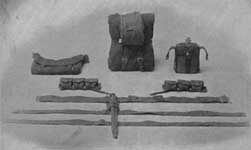 In the Mills Golden Jubilee booklet, The Development of the Mills Woven Cartridge Belt 1877-1956, Albert Lethern states that the Mills Company introduced, for the benefit of the smaller Territorial Associations, a modified, cheaper version of Web Equipment, Pattern 1908. This Territorial version is shown in the image at right, taken from page 27 of Lethern's booklet. As can be seen, a 3-inch wide version of this type of Belt was used with this simplified T.A. variation of Patt. '08. He does not give a date when this equipment was introduced, but it was definitely pre-war.
In the Mills Golden Jubilee booklet, The Development of the Mills Woven Cartridge Belt 1877-1956, Albert Lethern states that the Mills Company introduced, for the benefit of the smaller Territorial Associations, a modified, cheaper version of Web Equipment, Pattern 1908. This Territorial version is shown in the image at right, taken from page 27 of Lethern's booklet. As can be seen, a 3-inch wide version of this type of Belt was used with this simplified T.A. variation of Patt. '08. He does not give a date when this equipment was introduced, but it was definitely pre-war.
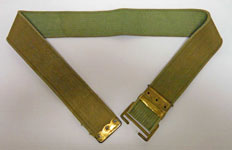
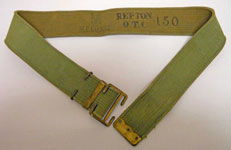 Another variation of the 2 1/4-inch wide O.T.C. Belt based on W.E. Patt. '08. This pre-war (1912) example is identical to the 1910 and 1926 dated Belts above, except that it has no rear buckled chapes. In Alfred Kruk's Patronentaschen, Patronengürtel und Banduliere 1850-1950, he pictures (pp. 335-336) a two pocket Cartridge carrier, also dated 1912, designed to be fitted to a 2 ¼-inch wide Belt such as this one. Interestingly, neither this Belt nor the Cartridge carrier has any provision for attaching Braces. We can only postulate that there were Brace attachments for the front, and some other fitment, possibly a slide with buckled chapes, for the rear. Can any reader come up with an example, or photographic evidence?
Another variation of the 2 1/4-inch wide O.T.C. Belt based on W.E. Patt. '08. This pre-war (1912) example is identical to the 1910 and 1926 dated Belts above, except that it has no rear buckled chapes. In Alfred Kruk's Patronentaschen, Patronengürtel und Banduliere 1850-1950, he pictures (pp. 335-336) a two pocket Cartridge carrier, also dated 1912, designed to be fitted to a 2 ¼-inch wide Belt such as this one. Interestingly, neither this Belt nor the Cartridge carrier has any provision for attaching Braces. We can only postulate that there were Brace attachments for the front, and some other fitment, possibly a slide with buckled chapes, for the rear. Can any reader come up with an example, or photographic evidence?
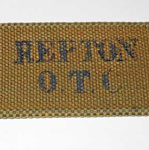 Marking details of this Belt. It is maker marked "M.E. Co.", size marked "M", dated 1912, and also marked to the "Repton O.T.C.". The Training Corps. marking is particularly gratifying, as it confirms that this type of Belt was used in officer's training. From the Karkee Web Collection.
Marking details of this Belt. It is maker marked "M.E. Co.", size marked "M", dated 1912, and also marked to the "Repton O.T.C.". The Training Corps. marking is particularly gratifying, as it confirms that this type of Belt was used in officer's training. From the Karkee Web Collection.
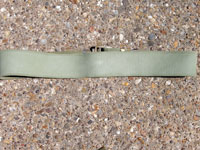
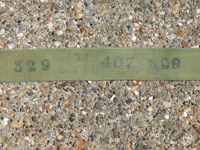
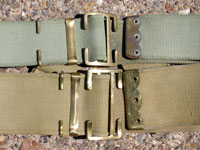 Another example of this type of Belt. Time and usage have obliterated the original maker's mark and date, although a faint "O.T.C." stamp is still visible. The photo near left shows a comparison of the O.T.C. Belt with the standard 3-inch wide infantry Patt. '08 Belt. From the Neil Griffiths Collection, photos © Neil Griffiths 2012.
Another example of this type of Belt. Time and usage have obliterated the original maker's mark and date, although a faint "O.T.C." stamp is still visible. The photo near left shows a comparison of the O.T.C. Belt with the standard 3-inch wide infantry Patt. '08 Belt. From the Neil Griffiths Collection, photos © Neil Griffiths 2012.
